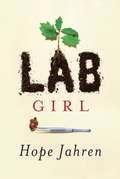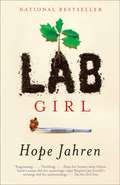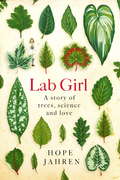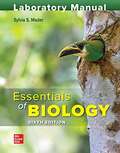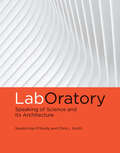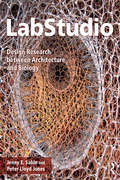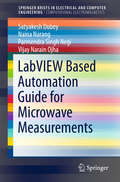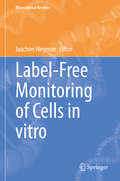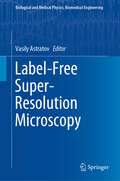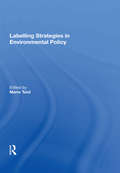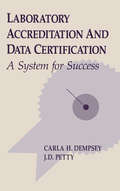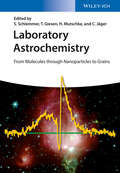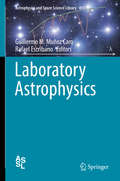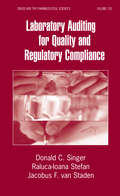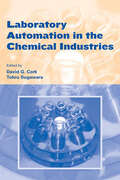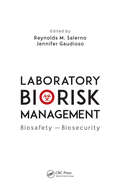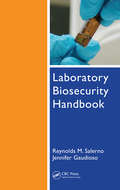- Table View
- List View
Lab Girl
by Hope JahrenAn illuminating debut memoir of a woman in science; a moving portrait of a long-time collaboration, in work and in life; and a stunningly fresh look at plants that will forever change how you see and think about the natural world.Acclaimed scientist Hope Jahren has built three laboratories in which she's studied trees, flowers, seeds, and soil. Her first book might have been a revelatory treatise on plant life. Lab Girl is that, but it is also so much more. Because in it, Jahren also shares with us her inspiring life story, in prose that takes your breath away. Lab Girl is a book about work, about love, and about the mountains that can be moved when those two things come together. It is told through Jahren's remarkable stories: about the things she's discovered in her lab, as well as how she got there; about her childhood--hours of unfettered play in her father's laboratory; about how she found a sanctuary in science, and learned to perform lab work "with both the heart and the hands"; about a brilliant and wounded man named Bill, who became her loyal colleague and best friend; about their adventurous, sometimes rogue research trips, which take them from the Midwest all across the United States and over the Atlantic, from the ever-light skies of the North Pole to tropical Hawaii; and about her constant striving to do and be the best she could, never allowing personal or professional obstacles to cloud her dedication to her work. Jahren's insights on nature enliven every page of this book. Lab Girl allows us to see with clear eyes the beautiful, sophisticated mechanisms within every leaf, blade of grass, and flower petal, and also the power within ourselves to face--with bravery and conviction--life's ultimate challenge: discovering who you are.From the Hardcover edition.
Lab Girl
by Hope JahrenA New York Times 2016 Notable BookNational Best SellerNamed one of TIME magazine’s "100 Most Influential People"An Amazon Top 20 Best Book of 2016A Washington Post Best Memoir of 2016A TIME and Entertainment Weekly Best Book of 2016 So Far An illuminating debut memoir of a woman in science; a moving portrait of a longtime friendship; and a stunningly fresh look at plants that will forever change how you see the natural world Acclaimed scientist Hope Jahren has built three laboratories in which she’s studied trees, flowers, seeds, and soil. Her first book is a revelatory treatise on plant life—but it is also so much more. Lab Girl is a book about work, love, and the mountains that can be moved when those two things come together. It is told through Jahren’s remarkable stories: about her childhood in rural Minnesota with an uncompromising mother and a father who encouraged hours of play in his classroom’s labs; about how she found a sanctuary in science, and learned to perform lab work done “with both the heart and the hands”; and about the inevitable disappointments, but also the triumphs and exhilarating discoveries, of scientific work.Yet at the core of this book is the story of a relationship Jahren forged with a brilliant, wounded man named Bill, who becomes her lab partner and best friend. Their sometimes rogue adventures in science take them from the Midwest across the United States and back again, over the Atlantic to the ever-light skies of the North Pole and to tropical Hawaii, where she and her lab currently make their home. Jahren’s probing look at plants, her astonishing tenacity of spirit, and her acute insights on nature enliven every page of this extraordinary book. Lab Girl opens your eyes to the beautiful, sophisticated mechanisms within every leaf, blade of grass, and flower petal. Here is an eloquent demonstration of what can happen when you find the stamina, passion, and sense of sacrifice needed to make a life out of what you truly love, as you discover along the way the person you were meant to be.
Lab Girl: A Story Of Trees, Science And Love
by Hope JahrenLab Girl is a book about work and about love, and the mountains that can be moved when those two things come together. It is told through Jahren's remarkable stories: about the discoveries she has made in her lab, as well as her struggle to get there; about her childhood playing in her father's laboratory; about how lab work became a sanctuary for both her heart and her hands; about Bill, the brilliant, wounded man who became her loyal colleague and best friend; about their field trips - sometimes authorised, sometimes very much not - that took them from the Midwest across the USA, to Norway and to Ireland, from the pale skies of North Pole to tropical Hawaii; and about her constant striving to do and be her best, and her unswerving dedication to her life's work.Visceral, intimate, gloriously candid and sometimes extremely funny, Jahren's descriptions of her work, her intense relationship with the plants, seeds and soil she studies, and her insights on nature enliven every page of this thrilling book. In Lab Girl, we see anew the complicated power of the natural world, and the power that can come from facing with bravery and conviction the challenge of discovering who you are.
Lab Manual And Workbook For Physical Anthropology
by Diane L. FranceNow in full color, Diane France's lab manual balances the study of human osteology, forensic anthropology, anthropometry, primates, human evolution, and genetics with a new chapter on growth & development, more material on disease and more on the anomalies of the human skeleton caused by disease and mechanical stress. Redundant and complex exercises have been pulled and the art program has been greatly enhanced with color images that include scales and orientation information. Exercises now contain thumbnail images of the related images for easy reference. In addition to providing hands-on lab assignments that help students apply physical anthropology perspectives and techniques to real situations, the Lab Manual provides a wealth of solid information and photographs that support the identification and observation problems that help make the concepts of physical anthropology easier to understand. This edition has been thoroughly reviewed, error-checked, revised and updated for complete accuracy and more balanced coverage of topic material.
Lab Manual For Human Biology (Thirteenth Edition)
by Sylvia MaderContains laboratory exercises and activities in relation to human body and other biology texts
Lab Manual PHYSICAL Science AGS
by Donald H. Jacobs Robert H. MarshallThe STEM integration and real-world examples that show students the relevance of science in their daily lives, while providing comprehensive coverage of skills and concepts. Engaging Untamed Science videos captivate students and concise lessons motivate learners at a 4th-grade reading level, allowing them to concentrate on learning the content.
Lab Manual eBook for Criminalistics: Forensic Science, Crime, and Terrorism - 365-Day Access
by James E. GirardLab Manual eBook for Criminalistics: Forensic Science, Crime, and Terrorism is a digital-only eBook lab manual with 365-day access. This Lab Manual eBook consists of 12 related experiments created by James Girard and arranged by chapter. It provides hands-on practice to students, allowing them to apply key concepts presented in the text or eBook.
Lab Manual for Essentials of Biology
by Sylvia MaderThe 25 laboratory sessions in this manual have been designed to introduce beginning students to the major concepts of biology, while keeping in mind minimal preparation for sequential laboratory use. The laboratories are coordinated with Essentials of Biology, a general biology text that covers all fields of biology. In addition, this Laboratory Manual can be adapted to a variety of course orientations and designs. There are a sufficient number of laboratories and exercises within each lab to tailor the laboratory experience as desired. Then, too, many exercises may be performed as demonstrations rather than as student activities, thereby shortening the time required to cover a particular concept.
Lab Manual to Accompany Introductory Horticulture
by Carroll ShryThis manual has been designed to enhance the lab activities of the Introductory Horticulture, Fifth Edition, text. The activities in this lab manual have been used in a technical school setting, which provides the students with necessary practical application skills in math, agriscience, measurement, communication, problem solving, as well as academic background for entry level positions in the horticulture industry and for advanced studies at post-secondary college. This manual covers the following areas: career exploration; plant nomenclature; plant parts; soils and media for plant growth; basic landscape design; landscape planning; landscape maintenance; power and hand tools of the horticulture industry; and designing holiday arrangements. The activities in this manual vary in application, from group and crew to individual, using the hands-on approach to learning about the horticulture industry. This lab manual offers a myriad of ways for all students to explore agricultural education.
Lab Manual to Accompany Introductory Horticulture (Fifth Edition)
by Carroll ShryThis manual has been designed to enhance the lab activities of the Introductory Horticulture, Fifth Edition, text. The activities in this lab manual have been used in a technical school setting, which provides the students with necessary practical application skills in math, agriscience, measurement, communication, problem solving, as well as academic background for entry level positions in the horticulture industry and for advanced studies at post-secondary college. This manual covers the following areas: career exploration; plant nomenclature; plant parts; soils and media for plant growth; basic landscape design; landscape planning; landscape maintenance; power and hand tools of the horticulture industry; and designing holiday arrangements.
LabOratory: Speaking of Science and Its Architecture (The\mit Press Ser.)
by Chris L. Smith Sandra Kaji-O'GradyAn illustrated examination of laboratory architecture and the work that it does to engage the public, recruit scientists, and attract funding.The laboratory building is as significant to the twenty-first century as the cathedral was to the thirteenth and fourteenth centuries. The contemporary science laboratory is built at the grand scales of cathedrals and constitutes as significant an architectural statement. The laboratory is a serious investment in architectural expression in an attempt to persuade us of the value of the science that goes on inside. In this lavishly illustrated book, Sandra Kaji-O'Grady and Chris L. Smith explore the architecture of modern life science laboratories, and the work that it does to engage the public, recruit scientists, and attract funding.Looking at the varied designs of eleven important laboratories in North America, Europe, and Australia, all built between 2005 and 2019, Kaji-O'Grady and Smith examine the relationship between the design of contemporary laboratory buildings and the ideas and ideologies of science. Observing that every laboratory architect and client declares the same three aspirations—to eliminate boundaries, to communicate the benefits of its research programs, and to foster collaboration—Kaji-O'Grady and Smith organize their account according to the themes of boundaries, expression, and socialization. For instance, they point to the South Australian Health and Medical Institute's translucent envelope as the material equivalent of institutional accountability; the insistent animal imagery of the NavarraBioMed laboratory in Spain; and the Hillside Research Campus's mimicry of the picturesque fishing village that once occupied its site. Through these and their other examples, Kaji-O'Grady and Smith show how the architecture of the laboratory shapes the science that takes place within it.
LabStudio: Design Research between Architecture and Biology
by Jenny E. Sabin Peter Lloyd JonesLabStudio: Design Research between Architecture and Biology introduces the concept of the research design laboratory in which funded research and trans-disciplinary participants achieve radical advances in science, design, and applied architectural practice. The book demonstrates to natural scientists and architects alike new approaches to more traditional design studio and hypothesis-led research that are complementary, iterative, experimental, and reciprocal. These originate from 3-D spatial biology and generative design in architecture, creating philosophies and practices that are high-risk, non-linear, and design-driven for often surprising results.Authors Jenny E. Sabin, an architectural designer, and Peter Lloyd Jones, a spatial biologist, present case studies, prototypes, and exercises from their practice, LabStudio, illustrating in hundreds of color images a new model for seemingly unrelated, open-ended, data-, systems- and technology-driven methods that you can adopt for incredible results.
LabVIEW based Automation Guide for Microwave Measurements
by Satya Kesh Dubey Naina Narang P. S. Negi V. N. OjhaThe book is focused on measurement automation, specifically using the LabView tool. It explains basic measurements in a simplified manner with appropriate step-by-step explanations and discussions of instrument capabilities. It touches upon aspects of measurement science, microwave measurements and software development for measurement. The book can be used as a guide by technicians, researchers and scientists involved in metrology laboratories to automate measurements. The book explains the development process for automation of measurement systems for every step of the software development lifecycle. It covers system design and automation policy creation. The book uses a top-down approach which enables the reader to relate their own problems and develop a system with their own analysis. The book includes many examples, illustrations, flowcharts, measurement results and screenshots of a worked-out automation software for microwave measurement. The book includes discussions on microwave measurements-attenuation, microwave power and E-field strength. The contents of this book will be of interest to students, researchers and scientists working in the field of electromagnetism, antennas, communication and electromagnetic interference/electromagnetic compatibility (EMI/EMC).
Label-Free Biosensing: Advanced Materials, Devices and Applications (Springer Series on Chemical Sensors and Biosensors #16)
by Michael J. Schöning Arshak PoghossianThis volume summarizes the state-of-the-art technologies, key advances and future trends in the field of label-free biosensing. It provides detailed insights into the different types of solid-state, label-free biosensors, their underlying transducer principles, advanced materials utilized, device-fabrication techniques and various applications. The book offers graduate students, academic researchers, and industry professionals a comprehensive source of information on all facets of label-free biosensing and the future trends in this flourishing field. Highlights of the subjects covered include label-free biosensing with:· semiconductor field-effect devices such as nanomaterial-modified capacitive electrolyte-insulator-semiconductor structures, silicon nanowire transistors, III-nitride semiconductor devices and light-addressable potentiometric sensors· impedimetric biosensors using planar and 3D electrodes· nanocavity and solid-state nanopore devices · carbon nanotube and graphene/graphene oxide biosensors· electrochemical biosensors using molecularly imprinted polymers· biomimetic sensors based on acoustic signal transduction· enzyme logic systems and digital biosensors based on the biocomputing concept· heat-transfer as a novel transducer principle· ultrasensitive surface plasmon resonance biosensors · magnetic biosensors and magnetic imaging devices
Label-Free Monitoring of Cells in vitro (Bioanalytical Reviews #2)
by Joachim WegenerThis book is dedicated to label-free, non-invasive monitoring of cell-based assays and it comprises the most widely applied techniques. Each approach is described and critically evaluated by an expert in the field such that researchers get an overview on what is possible and where the limitations are. The book provides the theoretical basis for each technique as well as the most successful and exciting applications.Label-free bioanalytical techniques have been known for a long time as valuable tools to monitor adsorption processes at the solid-liquid interface in general – and biomolecular interaction analysis (BIA) in particular. The underlying concepts have been progressively transferred to the analysis of cell-based assays. The strength of these approaches is implicitly given with the name 'label-free': the readout is independent of any label, reagent or additive that contaminates the system under study and potentially affects its properties. Thus, label-free techniques provide an unbiased analytical perspective in the sense that the sample is not manipulated by additives but pure. They are commonly based on physical principles and read changes in integral physical properties of the sample like refractive index, conductivity, capacitance or elastic modulus to mention just a few. Even though it is not implied in the name, label-free approaches usually monitor the cells under study non-invasively meaning that the amplitude of the signal (e.g. electric field strength, mechanical elongation) that is used for the measurement is too low to interfere or affect. In contrast to label-based analytical techniques that are commonly restricted to a single reading at a predefined time point, label-free approaches allow for a continuous observation so that the dynamics of the biological system or reaction become accessible.
Label-Free Super-Resolution Microscopy (Biological and Medical Physics, Biomedical Engineering)
by Vasily AstratovThis book presents the advances in super-resolution microscopy in physics and biomedical optics for nanoscale imaging. In the last decade, super-resolved fluorescence imaging has opened new horizons in improving the resolution of optical microscopes far beyond the classical diffraction limit, leading to the Nobel Prize in Chemistry in 2014. This book represents the first comprehensive review of a different type of super-resolved microscopy, which does not rely on using fluorescent markers. Such label-free super-resolution microscopy enables potentially even broader applications in life sciences and nanoscale imaging, but is much more challenging and it is based on different physical concepts and approaches. A unique feature of this book is that it combines insights into mechanisms of label-free super-resolution with a vast range of applications from fast imaging of living cells to inorganic nanostructures. This book can be used by researchers in biological and medical physics. Due to its logically organizational structure, it can be also used as a teaching tool in graduate and upper-division undergraduate-level courses devoted to super-resolved microscopy, nanoscale imaging, microscopy instrumentation, and biomedical imaging.
Labelling Strategies in Environmental Policy
by Mario TeislEco-labelling programmes have been in existence for many years but their recent growth now extends to many products and services. The academic literature has grown in response and there have been several theoretical and empirical advances. This volume presents the best of previously published research on the design and effects of eco-labelling programmes. Whilst concentrating on the economic literature, the articles also approach the topic from a psychological, sociological and political point of view. Part One focuses on a range of theoretical developments, Part Two on empirical measurements of the effectiveness of eco-labelling, Part Three on the factors that influence the success and design of eco-labelling programmes and Part Four on the effects of eco-labelling on international trade and development.
Labor, Markets, And Agricultural Production
by Jan Douwe van der PloegFocusing on the complex and often contradictory relationships between agricultural production and markets, Labor, Markets, and Agricultural Production examines the micro-macro linkages between farm production, farm labor issues, and the degree of autonomy or dependency vis-Ã -vis markets. By comparing the case of farmers in Peru, generally regarded as peripheral agricultural producers, with that of European farmers able to easily access the centralized markets of the EEC, Dr. van der Ploeg is able to draw general conclusions about the ongoing process of commoditization of agriculture and the roles farmers play in agrarian development.
Laboratory Accreditation and Data Certification: A System for Success
by Carla H. Dempsey Jimmie D. PettyThis book provides descriptions of current laboratory accreditation schemes and explains why these schemes fall short of assuring data purchasers that the data produced from accredited laboratories are always quality products. The book then presents a system for laboratory accreditation in conjunction with data certification that assures data purchasers their data are useful for the purposes for which they are intended. Simple quality assurance and quality control techniques, in addition to concepts of total quality management, are described and then applied to the environmental laboratory industry. This "System For Success" was developed from real problems and real solutions within the industry and represents an integration of proven techniques that offer a better way to ensure quality laboratory data is obtained. Laboratory Accreditation: A Workable Solution is a must for government officials, environmental professionals, independent environmental laboratories, hazardous waste disposal industries, chemical manufacturers, QA professionals, and testing laboratories.
Laboratory Astrochemistry
by Thomas Giesen Stephan Schlemmer Harald MutschkeWritten by leading scientists in the field and intended for a broader readership, this is an ideal starting point for an overview of current research and developments. As such, the book covers a broad spectrum of laboratory astrophysics and chemistry, describing recent advances in experiments, as well as theoretical work, including fundamental physics and modeling chemical networks. For researchers as well as students and newcomers to the field.
Laboratory Astrophysics (Astrophysics and Space Science Library #451)
by Guillermo M. Muñoz Caro Rafael EscribanoThis book focuses on the most recent, relevant, comprehensive and significant aspects in the well-established multidisciplinary field Laboratory Astrophysics. It focuses on astrophysical environments, which include asteroids, comets, the interstellar medium, and circumstellar and circumplanetary regions. Its scope lies between physics and chemistry, since it explores physical properties of the gas, ice, and dust present in those systems, as well as chemical reactions occurring in the gas phase, the bare dust surface, or in the ice bulk and its surface. Each chapter provides the necessary mathematical background to understand the subject, followed by a case study of the corresponding system. The book provides adequate material to help interpret the observations, or the computer models of astrophysical environments. It introduces and describes the use of spectroscopic tools for laboratory astrophysics. This book is mainly addressed to PhD graduates working in this field or observers and modelers searching for information on ice and dust processes.
Laboratory Auditing for Quality and Regulatory Compliance
by Donald C. Singer Raluca-Ioana Stefan Jacobus F. van StadenIdentifying current tools, techniques, and approaches for the evaluation of laboratory operations, this reference reviews the latest regulatory standards and auditing practices to test laboratory safety, quality, and performance.
Laboratory Automation in the Chemical Indus
by David G. Cork Tohru SugawaraFeaturing extensive calculations and examples, this reference discusses theoretical and practical aspects of short-circuit currents in ac and dc systems, load flow, and harmonic analyses to provide a sound knowledge base for modern computer-based studies that can be utilized in real-world applications. Presenting more than 2300 figures, tables, and equations, the author explores matrix methods for network solutions and includes load flow and optimization techniques. He discusses ac and dc short-circuit systems calculations in accordance with standards set by the American National Standards Institute (ANSI) and the International Electrotechnical Commission (IEC).
Laboratory Biorisk Management: Biosafety and Biosecurity
by Reynolds M. Salerno Jennifer GaudiosoOver the past two decades bioscience facilities worldwide have experienced multiple safety and security incidents, including many notable incidents at so-called "sophisticated facilities" in North America and Western Europe. This demonstrates that a system based solely on biosafety levels and security regulations may not be sufficient.Setting the s
Laboratory Biosecurity Handbook
by Reynolds M. Salerno Jennifer Gaudioso Benjamin H. BrodskyIn recognition of the vital need to protect legitimate facilities from the theft and misuse of dangerous pathogens and toxins, the Laboratory Biosecurity Handbook serves as a guide to the implementation of pathogen protection programs. The first sections of the book offer an historical overview of biological weapons activity, key principles of biosecurity and its integration into existing frameworks, as well as a discussion of biosecurity risk. Later sections discuss biosecurity risk assessments, describe detailed components of a biosecurity program, and offer a graded approach to biosecurity through multiple risk levels. The work also covers risk prioritization of biological assets and biosecurity training.
